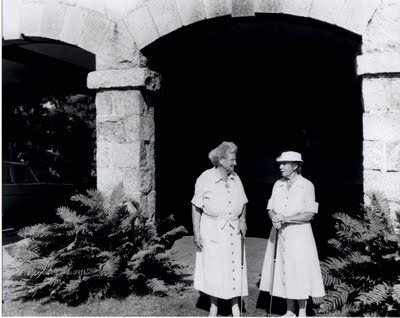Wealthy Massachusetts sisters helped the poor and needy
 There was much, much more
There was much, much moreto Harriot and Margaret, than
just the Curtis Cup ....
FROM THE UNITED STATES GOLF
ASSOCIATION WEBSITE
By David Shefter
If Harriot and Margaret Curtis were alive today, the sisters likely would have been among the first responders in New Orleans after Hurricane Katrina, or quickly jumped on a plane to aid victims of the recent earthquake in Haiti.
While the two Massachusetts natives (pictured) were best known for their exploits on the golf course, combining to win four US Women’s Amateur titles and donating the trophy for the biennial Curtis Cup Match, they were most proud of their charitable efforts within New England and abroad.
Born into a wealthy New England family, Harriot and Margaret developed a sense of helping the less fortunate from an early age. They continued the effort much of the rest of their lives; Margaret died in 1965 at the age of 82, and Harriot died nine years later at 93.
In 1909, the pair co-founded the Maverick Dispensary, an East Boston health clinic for Italian Americans. The organisation served 2,000 patients in its first year and by the 1930s, that figure had grown to 40,000 patient visits annually. The staff included dentists, an eye specialist, internists and other medical personnel. Fees were covered through private donations spearheaded by the Curtis sisters.
Upon the outbreak of World War I, Harriot was appointed director of the Associated Charities in Boston, and she worked at the Center for French Wounded and the Home Service Division of Civilian Relief.
Following the war, she became the dean of women at Hampton Institute, a college for African-American students in Richmond, Virginia, from 1927-31. Margaret was among the first graduates of the Simmons College School of Social Work in 1904.
By 1916, she was headed to Paris to assist with World War I relief in France, where she would receive the Medaille de Guerre from the French Red Cross (1919) and the Medaille de la Reconnaissance Francaise from the French government (1920) for her benevolence.
The charitable exploits of the sisters can be charted through material at the USGA Museum (at Far Hills, New Jersey) and the Arnold Palmer Center for Golf History. Margaret wrote many letters back to the U.S. about her experiences in Europe during World War I.
All of this came after she won three US Women’s Amateur titles, in 1907 (when she defeated Harriot in the final), 1911 and 1912. The two honed their golf skills at Essex County Club in Manchester-by-the-Sea, Massachusetts, where this year’s Curtis Cup Match will be played June 11-13. At first, French agencies were sceptical of American volunteers such as Margaret Curtis, mainly because of the language barrier. Margaret was acutely aware of this gap and took French lessons twice a week.
While the United States would not fully enter the conflict until 1917, a full year after Margaret’s arrival in Paris, the younger Curtis sister helped build goodwill in France ahead of the arrival of the American Red Cross.
That first year in Paris, Margaret worked hard to learn the practices of her boss, Mrs. Shurtleff, the head of the Student Atelier Association, an affiliate of the Red Cross. One of her initial tasks was to create a format for information cards that would serve as case records for an individual client or family.
“I took my face card up to Mrs. Shurtleff this morning,” wrote Margaret. “She rather laughed at its elaborateness, but said if I wanted it, and as I had agreed to stand all expenses and leave it so that anyone else could use the system, I was welcome to go ahead… I am trying hard to go slowly and keep from forming opinions too soon. I like Mrs. Shurtleff very much and I think her judgment seems very good… naturally, I don’t even know that much…”
As the workload increased, Margaret found less time to write home with news, despite the urging of family members to continue the correspondence. “Most of our time is spent investigating and visiting the new families which come in at the rate of about three a day,” Margaret wrote. “We try to draw the line at ‘Paris poor’ but where there’s a problem of sickness or acute misery due to war, we do plunge a bit. Alice (Sturgis) has taken over the ouvrier, which means quite a lot of work. One morning a week she gives out work and pays for what they bring; but besides that she has to see to having things cut out and decide what’s best to be made out of the quaint things that are sent, such as little boys’ pants out of a lady’s riding habit skirt.” Margaret took a two-month summer respite at home in Massachusetts before returning to Paris after Mrs. Shurtleff pleaded for her to return. France suffered under typical war-time conditions. Stores were ordered closed by 6 p.m., and half the lights were extinguished in the subway stations, coal being a precious commodity. Female street-car conductors and subway ticket takers were noticeably tense.
Many hotels served as hospitals, and young French girls were forbidden to leave their homes without an older companion. Once the U.S. declared war on Germany in the spring of 1917, the emotional climate changed, and Margaret expressed those feelings in a letter.
“I feel sort of blown up with news and excitement,” she wrote, “but I suppose once I try to put it on paper it’ll evaporate. It really is a wonderful sensation to be here these days…The next day all the French people were in a state of exaltation, but the second day there seemed to be more sadness at the idea of another big country being plunged in, than unmixed joy.”
Once the American Red Cross arrived in France in June 1917, the plan was to absorb the various relief organisations that were already in operation in Paris. Many of these agencies had been in place since the outbreak of war in 1914, while the Red Cross didn’t have much experience in the work going on in Paris.
Compromises were eventually made and departments were created within the Red Cross. Margaret’s concerns for better co-ordination were recognized, and the Red Cross gave her vast responsibilities for the merging of these relief agencies. She was appointed assistant to the chief of refugee affairs in Paris, and soon became the chef du bureau.
While the Battle of the Marne raged in 1918 just 30 miles from Paris, Margaret directed operations to handle the huge influx of refugees into the city. Her sister Elinor wrote, “We are all puffed up over your importance and competence.”
Harriot’s correspondence wasn’t so flattering. “Goodness, Petty (nickname), are you that fat? All your friends on first sight of you are overcome. I’d hate to tell you what they say and write. For pity’s sake, do you never take a step of exercise? ... Ma gives out that you are the most important person in Paris…says ‘She is a very intelligent girl.’ Ho Ho Ho.”
A year later, Margaret wrote to her family updating the situation in Paris. The agency had turned 24 houses into “logements” for about 750 families. When she had returned home that summer, a Red Cross captain wrote to Margaret about her successes. “The housing scheme of yours has proved a splendid success,” he wrote. “All the houses are still packed full. The rents have been paid very regularly and I have already collected over 100,000 francs from the various French organizations.”
After the war ended, Margaret remained active in relief efforts throughout Europe. While refugees were no longer streaming into Paris, uprooted villagers returned home to find their dwellings turned to rubble, with nothing to eat because gardens had turned to wasteland.
In the spring of 1919, she travelled through the countryside setting up small warehouses that served as distribution centers. Two years later, Margaret joined the active service of the Society of Friends in establishing health clinics in Austria, Poland and Czechoslovakia.
“Warsaw is quite a big showy city,” Margaret wrote of the Polish capital. “The streets are crowded with people – most of them extraordinarily well shod, but there are slews of beggars, particularly around church doors.
“We visited the Headquarters of the Russian Red Cross, and it was a nightmare. Horribly jammed in an ouvrier, a squalid restaurant for “Intelligentsia” and an awful canteen for kids – eight women were squashed into a coal hole, paring potatoes; three were teachers, and awful looking wrecks…blue hands everywhere, and to cap the climax, an old lady had gone crazy and was clutching our arms, begging rags.
"The Poles hate ’em – and they can’t go back to Russia, even if they could live there, once they crossed the border.”
War still raged in the Balkans and Asia Minor. In 1920, tensions flared between Greece and Turkey, the latter battling to regain territory lost through postwar treaties. In Athens, relief agencies were created and Margaret helped the Disaster Relief Commission try to meet the needs of thousands in exodus from Asia Minor.
Margaret stayed in Greece until 1923 when, told of her mother’s death, she returned home. Margaret continued her charitable duties during the years of World War II. She was a member of the War Production Board from 1942-45 and was also in charge of placing European children into Massachusetts homes.
Many of these were English children, sent to the United States by parents who feared for their safety in the continuous bombing of London. Margaret took an interest in a mother and her four children, settling them on the Curtis’ Manchester estate. Margaret’s kindness was remembered by Elaine Campbell-Jones, who continued to send Christmas cards from Bath, England, long after the war concluded.
Margaret and Harriot Curtis will be remembered for their collection of hard-won national golf titles and their founding of the Curtis Cup, but their service to the poor, the wounded and the oppressed prove that they were champions off the course as well.
*David Shefter is a USGA communications staff writer. E-mail him with questions or comments at dshefter@usga.org.
.
-->
Labels: CURTIS CUP










<< Home